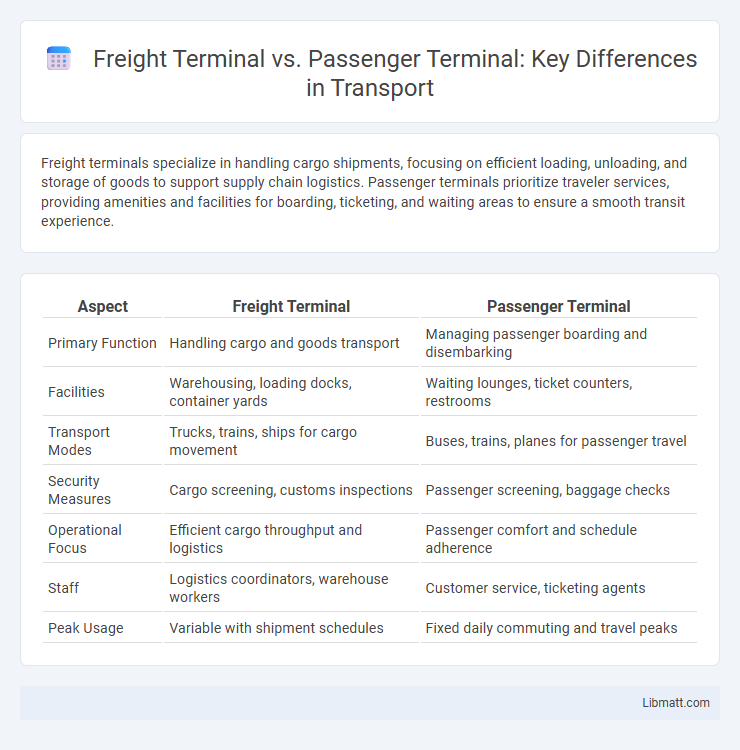Freight terminals specialize in handling cargo shipments, focusing on efficient loading, unloading, and storage of goods to support supply chain logistics. Passenger terminals prioritize traveler services, providing amenities and facilities for boarding, ticketing, and waiting areas to ensure a smooth transit experience.
Table of Comparison
| Aspect | Freight Terminal | Passenger Terminal |
|---|---|---|
| Primary Function | Handling cargo and goods transport | Managing passenger boarding and disembarking |
| Facilities | Warehousing, loading docks, container yards | Waiting lounges, ticket counters, restrooms |
| Transport Modes | Trucks, trains, ships for cargo movement | Buses, trains, planes for passenger travel |
| Security Measures | Cargo screening, customs inspections | Passenger screening, baggage checks |
| Operational Focus | Efficient cargo throughput and logistics | Passenger comfort and schedule adherence |
| Staff | Logistics coordinators, warehouse workers | Customer service, ticketing agents |
| Peak Usage | Variable with shipment schedules | Fixed daily commuting and travel peaks |
Introduction to Freight and Passenger Terminals
Freight terminals specialize in handling cargo shipments, facilitating the transfer, storage, and distribution of goods through various transportation modes such as rail, road, and sea. Passenger terminals are designed to accommodate travelers, providing facilities for boarding, ticketing, and customs clearance in airports, train stations, and bus terminals. Understanding the distinct operational functions of each terminal type helps optimize logistics efficiency and improve your travel experience.
Core Functions: Freight vs Passenger Terminals
Freight terminals primarily handle the loading, unloading, storage, and distribution of goods, focusing on efficient cargo transfer and logistics management. Passenger terminals are designed to accommodate travelers, offering amenities for ticketing, waiting, boarding, and baggage handling to ensure smooth passenger flow. Your choice between these terminal types depends on whether the priority is moving goods or facilitating human transit.
Design and Infrastructure Differences
Freight terminals feature robust infrastructure designed for heavy cargo handling, including large loading docks, extensive storage yards, and specialized equipment like cranes and forklifts. Passenger terminals prioritize passenger comfort and efficient movement, with amenities such as waiting lounges, ticket counters, security checkpoints, and clear signage. Your experience in a passenger terminal is centered around streamlined access and safety, while freight terminals optimize operational capacity and cargo flow.
Cargo Handling vs Passenger Services
Freight terminals specialize in cargo handling, including loading, unloading, storage, and customs processing to ensure efficient movement of goods. Passenger terminals focus on passenger services such as ticketing, security screening, boarding, and amenities to enhance traveler comfort and safety. Understanding the distinct operations of these terminals helps optimize your logistics or travel experience.
Security Measures in Each Terminal Type
Freight terminals implement rigorous security measures including cargo screening, perimeter fencing, surveillance cameras, and strict access controls to prevent theft, smuggling, and unauthorized entry. Passenger terminals prioritize passenger screening through metal detectors, X-ray machines, biometric identification, and controlled entry points to ensure traveler safety and prevent threats. Understanding these distinct security protocols helps you navigate or manage terminal environments effectively.
Technological Advancements in Terminals
Technological advancements in freight terminals center around automation, such as automated guided vehicles (AGVs) and advanced tracking systems, which enhance cargo handling efficiency and reduce turnaround times. Passenger terminals leverage digital check-in kiosks, biometric authentication, and real-time information displays to streamline traveler experience and improve security. Your ability to navigate these modernized terminals depends on the integration of IoT, AI, and data analytics, optimizing operations and customer service across both freight and passenger sectors.
Environmental Impact: Freight vs Passenger Operations
Freight terminals generate higher levels of greenhouse gas emissions and noise pollution due to heavy-duty diesel trucks and cargo handling equipment, contributing substantially to air quality degradation. Passenger terminals, while also causing emissions through buses and taxis, generally have lower overall environmental footprints per unit of throughput because of lighter vehicle loads and increased emphasis on public transit options. Efficient design and implementation of electrified equipment in both terminal types can significantly reduce their environmental impacts, promoting sustainability in transportation infrastructure.
Economic Significance of Terminal Types
Freight terminals drive economic growth by enabling the efficient movement of goods, reducing transportation costs, and supporting supply chain logistics critical to industries and trade. Passenger terminals boost local economies through tourism, business travel, and job creation associated with hospitality and transportation services. Your business strategy should consider the economic impact of each terminal type to optimize functionality and investment returns.
Challenges Faced by Freight and Passenger Terminals
Freight terminals face challenges such as coordinating complex logistics, handling large volumes of cargo efficiently, and managing security risks to prevent theft or damage. Passenger terminals must address overcrowding, ensure smooth crowd flow, and maintain high safety standards while providing timely information to travelers. Both types of terminals require advanced infrastructure and technology to optimize operations and minimize delays.
Future Trends in Terminal Development
Future trends in terminal development highlight the integration of advanced automation and smart technologies to boost efficiency and reduce operational costs in both freight and passenger terminals. Freight terminals are increasingly adopting AI-driven logistics and robotics for cargo handling and real-time tracking, while passenger terminals focus on contactless processing, biometric security, and enhanced passenger experience through IoT and data analytics. Sustainable infrastructure with energy-efficient designs and electric vehicle support systems are becoming critical in shaping the next generation of terminal facilities.
freight terminal vs passenger terminal Infographic

 libmatt.com
libmatt.com